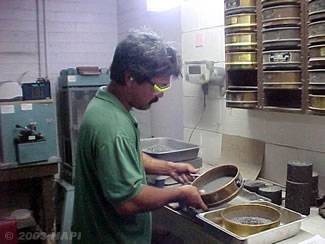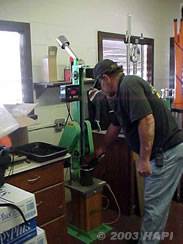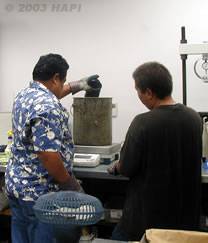HMA consists of two basic ingredients: aggregate and asphalt binder. HMA mix design is the process of determining what aggregate to use, what asphalt binder to use and what the optimum combination of these two ingredients ought to be. There are several different methods used to go about this process, of which the Hveem, Marshall and Superpave methods are the most common. The mix design fundamentals discussed here are applicable to all mix design methods.
Variables
HMA is a complex material upon which many different, and sometimes conflicting, performance demands are placed. It must resist deformation and cracking, be durable over time, resist water damage, provide a good tractive surface, and yet be inexpensive, readily made and easily placed. In order to meet these demands, the mix designer can manipulate all of three variables:
- Aggregate. Items such as type (source), gradation and size, toughness and abrasion resistance, durability and soundness, shape and texture as well as cleanliness can be measured, judged and altered to some degree.
- Asphalt binder. Items such as type, durability, rheology, purity as well as additional modifying agents can be measured, judged and altered to some degree.
- The ratio of asphalt binder to aggregate. Usually expressed in terms of percent asphalt binder by total weight of HMA or total weight of aggregate, this ratio has a profound effect on HMA pavement performance. Because of the wide differences in aggregate specific gravity, the proportion of asphalt binder expressed as a percentage of total HMA or aggregate weight can vary widely even though the volume of asphalt binder as a percentage of total volume remains quite constant.
Objectives
By manipulating the variables of aggregate, asphalt binder and the ratio between the two, mix design seeks to achieve the following qualities in the final HMA product (Roberts et al., 1996[1]):
- Deformation resistance. HMA should not distort (rut) or deform (shove) under traffic loading. HMA deformation is related to aggregate surface and abrasion characteristics, aggregate gradation, asphalt binder content and asphalt binder viscosity at high temperatures.
- Fatigue resistance. HMA should not crack when subjected to repeated loads over time. HMA fatigue cracking is related to asphalt binder content and stiffness.
- Low temperature cracking resistance. HMA should not crack when subjected to low ambient temperatures. Low temperature cracking is primarily a function of the asphalt binder low temperature stiffness. Obviously, this is not a major concern in Hawai’i.
- Durability. HMA should not age excessively during production and service life. HMA durability is related to air voids as well as the asphalt binder film thickness around each aggregate particle.
- Moisture damage resistance. HMA should not degrade substantially from moisture penetration into the mix. Moisture damage resistance is related to air voids as well as aggregate mineral and chemical properties.
- Skid resistance. HMA placed as a surface course should provide sufficient friction when in contact with a vehicle’s tire. Low skid resistance is generally related to aggregate characteristics or high asphalt binder content.
- Workability. HMA must be capable of being placed and compacted with reasonable effort. Workability is generally related to aggregate texture/shape/size/gradation, asphalt binder content and asphalt binder viscosity at mixing and placement temperatures.
Basic Procedure
No matter what specific method is used, the basic mix design procedure remains the same. All mix design processes involve three basic steps:
- Aggregate selection. Different agencies/owners specify different methods of aggregate acceptance. Typically, a battery of aggregate physical tests is run periodically on each particular aggregate source. Then, for each mix design, gradation and size requirements are specified. Normally, aggregate from more than one quarry stockpile is required to meet gradation specifications.
- Asphalt binder selection. Different authorities can and do specify different methods of asphalt binder evaluation. In Hawai’i, most agencies/owners use the Superpave PG system. Formerly, the aged residue (AR) viscosity grading system (a type of viscosity grading system) was used.
- Optimum asphalt binder content determination. Mix design methods are generally distinguished by the way in which they determine the optimum asphalt binder content. This process can be subdivided into:
- Make several trial mixes with different asphalt binder contents.
- Compact these trial mixes in the laboratory. This compaction is meant to be a rough simulation of actual field conditions.
- Run laboratory tests to determine key sample characteristics.
- Pick the asphalt binder content that best satisfies the mix design objectives.
Result: The Job Mix Formula (JMF)
The end result of a successful mix design is a recommended mixture of aggregate and asphalt binder. This recommended mixture, which includes aggregate gradation and asphalt binder type is often referred to as the job mix formula (JMF). The JMF may subsequently be altered based on field performance, however at a minimum the mix design provides the initial JMF. For HMA manufacturing, target values of gradation and asphalt binder content are specified based on the JMF along with allowable tolerance limits to allow for inherent material and production variability (see Table 1 and Figure 4). These target values and tolerance bands are based on the JMF and are much tighter than general HMA gradation requirements. Thus, the mix designer is allowed substantial freedom in choosing a particular gradation for the JMF and then the manufacturer is expected to adhere quite closely to this JMF gradation during production.
Table 1: Example Job Mix Formula (JMF) with Specification and Tolerance Bands
| Sieve (metric) | 19.0 mm | 12.5 mm | 9.5 mm | 2.36 mm | 0.075 mm |
| Sieve Size (U.S. units) | 3/4 inch | 1/2 inch | 3/8 inch | No. 8 | No. 200 |
| Gradation Control Points | 100 min. | 90 – 100 | 90 max. | 28 – 58 | 2.0 – 7.0 |
| Job Mix Formula (JMF) | 100 | 96 | 75 | 29 | 4.5 |
| Tolerance | 99 – 100 | +/- 6% | +/- 6% | +/- 4% | +/- 2.0% |
| Tolerance Limits | 99 – 100 | 90 – 100 | 69 – 81 | 25 – 33 | 2.5 – 6.5 |
- Hot Mix Asphalt Materials, Mixture Design, and Construction. National Asphalt Pavement Association Education Foundation. Lanham, MD.↵



